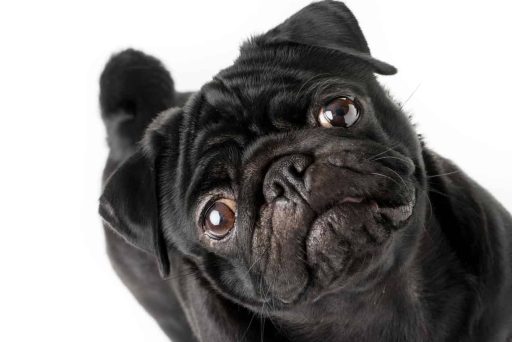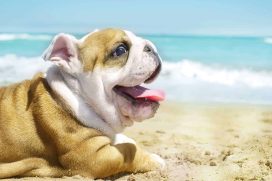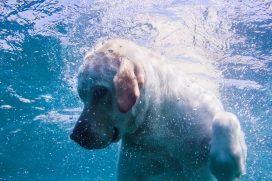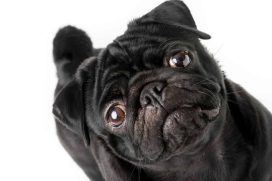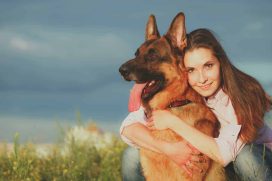Black pugs are essentially the same breed as a fawn pug. Fawn pugs are your typical pug that you will see out and about and tend to be more popular than the black pug. Fawn pugs are the more common type of pug, and is simply because more people find the black mask of a fawn pug cuter and more enduring.
The black pug is the same as other pugs temperament and health-wise, with the main difference between a black pug and a fawn pug being the pug’s coat color. In this article I’ll explain everything you need to know about black pugs, from their temperament to their trainability.
What Is A Black Pug?
Black pugs are pugs that have a black, dark coat. They generally grow to about 10-13 inches tall at the shoulder. They typically weight anywhere from 14 to 18 pounds, but can weigh a lot more if they overeat as they are prone to putting on weight easily.

Black Pugs are charming, loving, and a bit mischievous. They are a small but sturdy breed whose main purpose in life is to love and be loved in return. They are happiest when they live in a home where they get lots of attention and they know they are well-loved.
What Kind Of Coat Does A Black Pug Have?
A pug can be fawn, silver, apricot, brindle, and black.
The Black Pug is usually black in color from head to toe, but may have some white colored coat on the chest.
The AKC only recognizes fawn and black pugs, with other colors not accepted as a true representation of the pug breed. All colors of pugs other than black and brindle have a black mask.
The Black Pug can be a double or single coat pug. The single coat is most common in the black pug , with the double coat more common in pugs with fawn and brindle colored coats. Those with a double coat have a thick undercoat similar to other double coated breeds. The top coat has the same look and feel in both double and single coated black pugs

When it comes to pug genetics, the black coat gene is the dominant gene. This means that if even one of the parents has a black coat, the puppies will be black unless there are two recessive fawn genes present. To consistently produce fawn pug puppies both parents should be fawn.
What Temperament Do Black Pugs Have?
Black pugs are known as an even-tempered and stable breed. They are playful with a loving and outgoing disposition. Pugs are always on the lookout for ways to show love to their people.
Are Black Pugs Good Family Dogs?
Black pugs can do well in a variety of environments and households. They will do well with families with kids, especially if the pug is well socialized with children and the children are taught how to treat dogs.
Black pugs can enjoy the company of other pets, whether that pet is another dog or a cat or even a hamster! Black pugs usually enjoy having company come to visit too, and can be very welcoming.
A black pug will do just as well in a single person household as long as he still gets plenty of love and attention. Black pugs will not do well if left alone for long periods of time.

Do black pugs do well with other dogs and animals?
Pugs usually get along very well with other dogs and pets. They usually aren’t too interested in chasing or harassing the family cat or guinea pig. Pugs mostly just want to be friends with everyone!
Black pugs are very well suited to apartment life if they are given enough exercise. A pug can also be happy ambling about in the countryside and running on the beach if given the opportunity.
The main things that a pug needs in his environment to help him thrive is lots of love and air conditioning. Because this is a short-nosed breed they can overheat very quickly so air-conditioning is a must. Oh and as long as you don’t mind snoring this should be a good choice of breed for you!
Are Black Pugs Easy To Train?
Yes, black pugs can be very trainable, much like all other pugs.
Like all breeds, they require consistent, positive training methods. This method should focus on what you do want your pug to do and not what you do not want him to do. It is said that pugs can be stubborn at times, but once you find the right motivation for him, training should be a lot easier.
So, keep training sessions short and fun. Once your pug knows a few commands intersperse them among new commands you are trying to teach. This will help to prevent boredom. It is also a good idea to use a variety of rewards when your pug does what you want him too. Use praise, a game, or a variety of treats.
When training use very small treats. This is important because pugs are small dogs. The smaller the treats you use to more training you can get in before you fill your pug up or make him gain weight. Treats about the size of a pea or smaller are a good choice. Also, choosing a treat that is only made of meat is a great option. These treats will offer healthy nutrients while also being delicious for your pug.
This video briefly shows how to train a black pug puppy to leave a treat on command.
Pugs usually get along well with everyone but socialization is still very important in the breed. Pugs should have positive interactions with all sorts of people, animals, places, noises, smells, and sights. This socialization starts when they are puppies and should be a lifelong training practice.
Most pugs do well with 30-40 minutes of exercise a day. This could include play sessions or walkies. It is best to walk a pug using a harness, regular collars can be quite uncomfortable to the breed because of all their chest and neck skin. Wearing a collar can also make breathing difficult. Also, be sure to always bring along plenty of water if it’s warm, and don’t play outside when it is too hot or humid.
How Do You Groom A Black Pug?
Pugs are heavy shedders and will shed all year-round. They will shed especially heavily in spring and fall. Just petting or rubbing a pug often results in loose hairs sticking to your hands and clothes. However, the grooming of your pug can easily be done by you in your own home, with no need for a professional groomer.
Interestingly fawn-colored pugs mostly have double coats while black pugs usually have a single coat. This means that the black pug typically sheds less than a fawn colored pug.
However, because the pug is a heavy shedder is it recommended that they are brushed at least once a week to reduce fur buildup around your home.
Here’s an experienced pug owner showing how she grooms her pug
1. Brushing
To brush your pug you can use a Furminator styled brush. These are especially good for removing fur from dogs who shed heavily.
Start brushing around the neck, as this typically sheds the most, working your way back to the base of the tail.
Brush the fur in the direction that it grows, and it’s a good idea to have a container of some sort nearby to put the removed hair into.
Rub the dog all over with your hands, back and forth, with and against the way the fur grows. This will help to remove any remaining loose hair.
Finish off the brushing with a pin brush. Gently brush the fur against the way it grows with the pin brush. This will mostly just fluff the coat and remove a few more hairs.
2. Bathing
It is a good idea to bathe your pug about once a month. Bathing will help to remove fur. You may want to give your pug a rinse off if he gets particularly dirty on a walk as well.
Use a mild dog shampoo and conditioner and be sure to rinse thoroughly. Avoid getting the folds on the face wet, you’ll want to clean your pug’s face at another time.
3. Face Cleaning
The facial skin folds on a pug need to be cared for too. How often you clean the facial folds will depend upon the dog. Pugs with deeper wrinkles will need their folds cleaned more often than those with shallow wrinkles. Also, if a fold starts to smell this can be a sign of bacteria build up so cleaning it will help to stop a possible infection starting.
To clean your pugs face folds you will need some wipes. You can use wipes that are made for cleaning face folds or you can use fragrance-free, sensitive baby wipes.
With one hand gently move the skin back toward the back of the head. Use a finger of the other hand wrapped in the wipe to carefully clean the exposed skin. Be very gentle, and avoid the eyes. After cleaning with the wipes it is a good idea to dry the wrinkles with a cotton ball. Be sure not to leave the wrinkles damp, as this can allow bacteria to grow under the fold.
4. Ear Cleaning
It’s a good idea to keep an eye on your pug’s ears and clean them if you see a bit of build-up in there. Use a cotton ball soaked in a mixture of half apple cider vinegar and half filtered water.
5. Nail trimming
It is a good idea to trim your black pug’s nails on a weekly basis. This will help to keep the nails short and healthy. Long nails can be anything from painful to throwing your dog’s back out of alignment, so keep them trimmed.
6. Dental Care
Cleaning your black pug’s teeth is an important part of his care program. While most dog toothpaste recommends brushing your dog’s teeth 2-3 times a week it’s easier to remember if you just do it daily. Brushing your pug’s teeth on a daily basis is a great way to keep tabs on his health and prevent a host of health issues. Providing your pug with appropriate things to chew on such as toys or treats is important for oral health as well.
While the black pug typically sheds less than a fawn pug they are not considered hypoallergenic. Even a black pug will shed 365 days a year.
What Health Problems Can Black Pugs Have?
One of the reasons pugs are so adorable is because of their flat, mushed faces. Unfortunately, these adorable faces can make the pug prone to breathing difficulties. This is one reason why pugs do not do well in heat and humidity. This intolerance of heat is exacerbated by the black coat of a black pug, as it absorbs the heat from the sun faster than a fawn pug. So, always be sure to keep them cool.
The black pug can suffer from the luxating patella. This is where the kneecap dislocates and causes pain. It will also cause problems with walking.
Pugs also have large protruding eyes, another reason we love them. Again, however, these eyes can be prone to problems. Generally, they can get poked by grass or other things. A pug’s eyes can easily have something fall into them as well such as grass seeds or sand. It is a good idea to have a saline solution on hand to be able to use at the first sign of an eye issue.
The wrinkles on the face of a pug can also be a breeding ground for bacteria. But this is easily avoided with proper cleaning of the face wrinkles.
What’s The Best Food For Black Pugs?
Pugs can be prone to weight gain. That is why it is super important that you feed your pug a high-protein, low-carb diet. While a pug may not look like his wolf ancestors, he is still a carnivore. The food that you choose to feed your pug is one of the most important decisions that you will make for him. His food is one of the most important aspects of disease prevention and longevity.
You can choose from kibbles, canned foods, home-cooked foods, and even raw diets. But across the board of food types, you want food that provides your pug with lots of protein and little to no carbs. Foods high in carbohydrates will make your pug gain weight and have trouble losing weight.
When feeding your pug a commercially produced diet be sure to follow the manufacturer’s directions on how much to feed. But also pay attention to your pug. If he is losing weight, feed him a little more. If he is gaining weight, feed him a bit less. Remember you are the one putting the food in his bowl, so you are in control of your pug’s weight.
If your pug gains weight on one food and you reduce the amount he is eating and he still doesn’t lose weight, you might want to switch foods. Something in the food he is eating may not agree with his system or it might have more carbs than you thought. Sometimes switching to a different food is all you need to do to help your pug lose that extra weight.
Be sure to provide your pug with plenty of things to chew on, this will help to maintain healthy teeth and gums. Good options include bully sticks, dehydrated trachea, lamb ears, and other non-rawhide yet natural animal chews.
Feeding your pug an Omega-3 fatty acid supplement can be helpful in reducing shedding. Omega-3s also support healthy eyes, heart, joints, and brain.
Provide your pug with plenty of fresh cool water. It is especially important to have water handy when you take your pug for a walk or an outing. This will help him to stay cool.
Here’s a very informative video, explaining what YouTube sensation, Doug The Pug eats to stay fit and healthy.
Where Can You Get A Black Pug And How Much Do They Cost?
Pug puppies can be anywhere from free to $3000 or more. It all depends on where you get the pug and what you intended to do with your pug. If you are buying a pug to show him, then you are going to be paying the higher end of the spectrum. If you are buying a pug as a pet and get it from a great breeder, then you’ll be paying less than you would for a show quality dog.
Why do black pug puppies cost so much?
One reason for the high cost of black pug puppies is that it is often required that they are born by c-section. This means that the mother must endure surgery which is an extra expense to the breeder. Anywhere from $600-$2,000 is what a c-section can cost. Even with a c-section the puppies and mother may not survive. Keep that in mind if you ever think you want to breed pugs!
Since pugs can suffer from so many health problems it is best to seek out an excellent breeder if you are interested in adding a black pug to your family. A good breeder is going to choose parents for their litter that will produce the best puppies for the breed standard. This means when a good breeder chooses parents they are looking to create a puppy that will have the temperament and structure you would expect from a pug. A good breeder also wants to produce healthy puppies.
You can sometimes find pugs at pet stores or from backyard breeders, but you are unlikely to find a well-bred pug from these sources. Typically a backyard breeder or pet store is simply looking to make a profit and cares very little about how well the puppy was bred. Please, do not support puppy mills by purchasing a puppy from a pet store. And do not encourage backyard breeders by purchasing from them either. Shelters are often full of dogs and puppies from puppy mills and backyard breeders.
A good breeder will not breed a litter until they know that all the puppies likely to come from the litter will have a home. When looking for a breeder check to see if they do the following health checks on the parents: Hip Evaluation, Patella Evaluation, Ophthalmologist Evaluation, and Pug Dog Encephalitis DNA Test. This will help to ensure the healthiest puppies.
You can find many AKC registered breeders on the AKC Marketplace. But remember to do your homework, just because a black pug pup is AKC registered does not mean it is well-bred. Look for additional badges and certifications from the AKC that the breeder is a good breeder. These can include Breeder of Heart and Breeder of Merit. Of course, go with your gut as well. If you get a creepy feeling from one breeder, then find another breeder.
That said, if you cannot afford to purchase a well-bred black pug puppy you can check local shelters or breed rescues. Here is a list of state-by-state pug rescues. Remember that these dogs were given up for a reason and it is highly likely that they did not come from good breeding. This means that a rescue pug is more likely to have health issues as well as temperament and physical issues. But if you are willing to work with these pugs where they are, they deserve forever homes too.
Summary – The Black Pug
Other than color there is little difference between the black pug and the fawn-colored pug. Black pugs ‘dogs will often shed a bit less than the fawn pugs. A black pug can be a great addition to any family, they are suitable for homes with kids and other pets. They enjoy apartment or country life as long as they get plenty of love and time with their people.
Pugs require, at least, weekly brushings and wrinkle cleanings. They benefit from occasional bathing. A pug does well with 30-40 minutes of exercise a day. Be sure to protect your pug from hot and humid weather.
Feeding your black pug a high-protein diet with little to no carbs is one of the best ways to prevent weight gain and disease in any dog. This breed is prone to breathing issues, eye issues, and some joint problems.
The key to a happy pug is plenty of love!
Sources
https://boogiethepug.com/a-complete-list-of-pug-rescues-in-the-usa/

